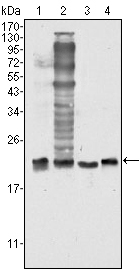
详细信息
组成
Liquid in PBS
纯度
SDS-PAGE >90%
储存
-20°C/6 month,-80°C for long storage
相关产品
抗原&靶点信息
序列:
Amino acid: full length, with his-MBP tag.
展开内容
基因名称:
SOD1
展开内容
蛋白名称:
SOD1 protein
展开内容
别名:
Superoxide dismutase [Cu-Zn] ;
Superoxide dismutase 1 ;
hSod1 ;
Superoxide dismutase 1 ;
hSod1 ;
展开内容
背景:
catalytic activity:2 superoxide + 2 H(+) = O(2) + H(2)O(2).,cofactor:Binds 1 copper ion per subunit.,cofactor:Binds 1 zinc ion per subunit.,disease:Defects in SOD1 are the cause of amyotrophic lateral sclerosis type 1 (ALS1) [MIM:105400]. ALS1 is a familial form of amyotrophic lateral sclerosis, a neurodegenerative disorder affecting upper and lower motor neurons and resulting in fatal paralysis. Sensory abnormalities are absent. Death usually occurs within 2 to 5 years. The etiology of amyotrophic lateral sclerosis is likely to be multifactorial, involving both genetic and environmental factors. The disease is inherited in 5-10% of cases leading to familial forms.,function:Destroys radicals which are normally produced within the cells and which are toxic to biological systems.,miscellaneous:The protein (both wild-type and ALS1 variants) has a tendency to form fibrillar aggregates in the absence of the intramolecular disulfide bond or of bound zinc ions. These aggregates may have cytotoxic effects. Zinc binding promotes dimerization and stabilizes the native form.,online information:ALS genetic mutations db,online information:Superoxide dismutase entry,PTM:Unlike wild-type protein, the pathogenics variants ALS1 Arg-38, Arg-47, Arg-86 and Ala-94 are polyubiquitinated by RNF19A; which leads to their proteasomal degradation.,similarity:Belongs to the Cu-Zn superoxide dismutase family.,subunit:Homodimer. The pathogenics variants ALS1 Arg-38, Arg-47, Arg-86 and Ala-94 interact with RNF19A, whereas wild-type protein does not.,
展开内容
功能:
MAPKKK cascade, activation of MAPK activity, response to reactive oxygen species, response to superoxide, response to oxygen radical, DNA catabolic process, endonucleolytic, cell morphogenesis, cell morphogenesis involved in differentiation, regulation of action potential, ovarian follicle development, leukocyte homeostasis, regulation of cytokine production, positive regulation of cytokine production, placenta development, tissue homeostasis, retina homeostasis, auditory receptor cell morphogenesis, myeloid cell homeostasis, immune system development,regulation of leukocyte activation, reproductive developmental process, muscle system process, circulatory system process, heart process, vascular process in circulatory system, DNA metabolic process, DNA repair, double-strand break repair, DNA catabolic process, DNA fragmentation involved in apoptosis, protein amino acid phosphorylation,peptide metabolic process, cellular amino acid derivative metabolic process, coenzyme metabolic process, glutathione metabolic process, sulfur metabolic process, phosphorus metabolic process, phosphate metabolic process, oxygen and reactive oxygen species metabolic process, superoxide metabolic process, cellular ion homeostasis, cellular iron ion homeostasis, apoptosis, anti-apoptosis, cell structure disassembly during apoptosis, regulation of muscle contraction,regulation of smooth muscle contraction, response to DNA damage stimulus, response to oxidative stress, nucleus organization, plasma membrane organization, cytoskeleton organization, intracellular signaling cascade, protein kinase cascade, ensheathment of neurons, gamete generation, spermatogenesis, peripheral nervous system development, sensory organ development, sex differentiation, female pregnancy, embryo implantation, aging, cell aging, sensory perception, sensory perception of sound, behavior, locomotory behavior, blood circulation, regulation of blood pressure, cell death, axon ensheathment, gonad development, female gonad development, macromolecule catabolic process, response to temperature stimulus, response to heat, response to wounding, response to abiotic stimulus, negative regulation of biosynthetic process, response to extracellular stimulus, glial cell differentiation,response to organic substance, response to inorganic substance, response to metal ion, negative regulation of steroid biosynthetic process, regulation of cell death, positive regulation of cell death, programmed cell death,Schwann cell differentiation, Schwann cell development, membrane organization, death, phosphorylation, regulation of lipid metabolic process, regulation of steroid metabolic process, regulation of phosphate metabolic process,transmission of nerve impulse, regulation of action potential in neuron, removal of superoxide radicals, cellular homeostasis, sexual reproduction, glial cell development, myelination in the peripheral nervous system, cellular component disassembly, ovulation cycle process, cellular cation homeostasis, cellular di-, tri-valent inorganic cation homeostasis, cell projection organization, neuron differentiation, apoptotic nuclear changes, response to nutrient levels, myelin maintenance in the peripheral nervous system, ensheathment of axons in the peripheral nervous system, multicellular organism reproduction, cellular component morphogenesis, regulation of T cell differentiation in the thymus, cellular response to stress, positive regulation of kinase activity, cellular response to oxidative stress,cellular response to reactive oxygen species, regulation of tube size, regulation of growth, regulation of multicellular organism growth, gliogenesis, vasodilation, regulation of phosphorylation, regulation of membrane potential, ear morphogenesis, inner ear morphogenesis, mechanoreceptor differentiation, auditory receptor cell differentiation,response to drug, response to hydrogen peroxide, myelination, superoxide anion generation, homeostatic process,ovulation cycle, hydrogen peroxide metabolic process, regulation of apoptosis, positive regulation of apoptosis,negative regulation of apoptosis, regulation of programmed cell death, positive regulation of programmed cell death,negative regulation of programmed cell death, positive regulation of catalytic activity, myelin maintenance, regulation of MAP kinase activity, positive regulation of MAP kinase activity, regulation of neuron apoptosis, negative regulation of neuron apoptosis, regulation of kinase activity, ear development, regulation of system process, positive regulation of molecular function, cellular macromolecule catabolic process, intermediate filament-based process, intermediate filament cytoskeleton organization, development of primary sexual characteristics, response to ethanol, regulation of cholesterol biosynthetic process, negative regulation of cholesterol biosynthetic process, regulation of T cell differentiation, regulation of lymphocyte differentiation, negative regulation of lipid metabolic process, regulation of protein kinase activity, positive regulation of protein kinase activity, negative regulation of muscle contraction,negative regulation of steroid metabolic process, negative regulation of smooth muscle contraction, development of primary female sexual characteristics, regulation of organ growth, female sex differentiation, response to copper ion,muscle maintenance, regulation of lipid biosynthetic process, male gamete generation, rhythmic process, hemopoietic or lymphoid organ development, thymus development, embryonic organ morphogenesis, embryonic organ development, embryonic morphogenesis, reproductive structure development, reproductive process in a multicellular organism, neuron development, cell morphogenesis involved in neuron differentiation, response to axon injury, inner ear development, multicellular organismal homeostasis, homeostasis of number of cells, chemical homeostasis,hydrogen peroxide biosynthetic process, ion homeostasis, regulation of steroid biosynthetic process, regulation of T cell activation, regulation of cell activation, neurological system process, regulation of blood vessel size, cognition,sensory perception of mechanical stimulus, negative regulation of lipid biosynthetic process, regulation of phosphorus metabolic process, cofactor metabolic process, positive regulation of multicellular organismal process, negative regulation of multicellular organismal process, regulation of lymphocyte activation, regulation of transferase activity,positive regulation of transferase activity, regulation of mitochondrial membrane potential, di-, tri-valent inorganic cation homeostasis, iron ion homeostasis, cation homeostasis, cellular chemical homeostasis, oxidation reduction,heart contraction, neurofilament cytoskeleton organization, relaxation of vascular smooth muscle, auditory receptor cell stereocilium organization, inner ear receptor cell differentiation, auditory receptor cell development, inner ear receptor cell development, inner ear receptor stereocilium organization, anatomical structure homeostasis, negative regulation of cell death,
展开内容
细胞定位:
Cytoplasm . Mitochondrion . Nucleus . Predominantly cytoplasmic; the pathogenic variants ALS1 Arg-86 and Ala-94 gradually aggregates and accumulates in mitochondria. .
展开内容
信号通路
Cellular Processes >> Transport and catabolism >> Peroxisome
Organismal Systems >> Aging >> Longevity regulating pathway - multiple species
Human Diseases >> Neurodegenerative disease >> Parkinson disease
Human Diseases >> Neurodegenerative disease >> Amyotrophic lateral sclerosis
Human Diseases >> Neurodegenerative disease >> Huntington disease
Human Diseases >> Neurodegenerative disease >> Prion disease
Human Diseases >> Neurodegenerative disease >> Pathways of neurodegeneration - multiple diseases
文献引用({{totalcount}})
Recently Viewed Products
Clear allToggle night Mode
{{pinfoXq.title || ''}}
Catalog: {{pinfoXq.catalog || ''}}
Filter:
All
{{item.name}}
{{pinfo.title}}
-{{pinfo.catalog}}
主要信息
Target
{{pinfo.target}}
Reactivity
{{pinfo.react}}
Applications
{{pinfo.applicat}}
Conjugate/Modification
{{pinfo.coupling}}/{{pinfo.modific}}
MW (kDa)
{{pinfo.mwcalc}}
Host Species
{{pinfo.hostspec}}
Isotype
{{pinfo.isotype}}
产品 {{index}}/{{pcount}}
上一个产品
下一个产品
{{pvTitle}}
滚轮缩放图片
{{pvDescr}}



















